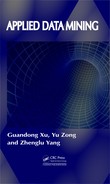is an improvement over the old. Evaluation of the subsets requires a scoring
metric that grades a subset of features. Exhaustive search is generally
impractical, so at some implementor (or operator) defi ned stopping point,
the subset of features with the highest score discovered up to that point is
selected as the satisfactory feature subset. The stopping criterion varies by
algorithm; possible criteria include: a subset score exceeds a threshold, a
program’s maximum allowed run time has been surpassed, etc. Alternative
search-based techniques are based on targeted projection pursuit which
fi nds low-dimensional projections of the data that score highly: the features
that have the largest projections in the lower dimensional space are then
selected. The classifi cation problem can be restricted to consideration of
the two-class problem without loss of generality. In this problem the goal
is to separate the two classes by a function which is induced from available
examples. The goal is to produce a classifi er that will work well on unseen
examples.
5.4 Chapter Summary
In this chapter, we’ve talk about some methods which are proposed in
classifi cation. Decision trees and Bayesian Network (BN) generally have
different operational profi les, when one is very accurate the other is not
and vice versa. On the contrary, decision trees and rule classifi ers have
a similar operational profi le. The goal of classifi cation result integration
algorithms is to generate more certain, precise and accurate system results.
Numerous methods have been suggested for the creation of an ensemble
of classifi ers. Although or perhaps because many methods of ensemble
creation have been proposed, there is as yet no clear picture of which method
is best. Classifi cation methods are typically strong in modeling interactions.
Several of the classifi cation methods produce a set of interacting loci that
best predict the phenotype. However, a straightforward application of
classifi cation methods to large numbers of markers has a potential risk
picking up randomly associated markers.
References
[1] http://en.wikipedia.org/wiki/Backpropagation.
[2] http://www.gov.bc.ca/citz/iao/records-mgmt/arcs-orcs/
[3] M. Aizerman, E. Braverman and L. Rozonoer. Theoretical foundations of the potential
function method in pattern recognition learning, 1964.
[4] R. Barros. Fa bottom-up oblique decision tree induction algorithm. In: 11th International
Conference on Intelligent Systems Design and Applications (ISDA), 2011, pp. 450–456,
2011.
[5] B. E. Boser, I. M. Guyon and V. N. Vapnik. A training algorithm for optimal margin
classifi ers. In: Computational Learning Theory, pp. 144–152, 1992.
Classifi cation 115
116 Applied Data Mining
[6] A. E. Bryson and Y. Ho. Applied optimal control: optimization, estimation, and control,
1975.
[7] C. C. and V. V. Support-vector networks. Machine Learning, 20: 273–297, 2007.
[8] G. Dong, X. Zhang and L. Wong. Caep: Classifi cation by aggregating emerging patterns,
pp 30–42, 1999.
[9] R. O. Duda and P. E. Hart. Pattern Classifi cation and Scene Analysis. John Wiley & Sons,
New York, 1973.
[10] S. hyuk Cha. A genetic algorithm for constructing compact binary decision trees. Journal
of Pattern Recognition Research, 4(1): 1–13, 2009.
[11] M. Kubat. Introduction to Machine Learning, 1992.
[12] P. Langley, W. Iba and K. Thompson. An analysis of bayesian classifi ers. In: Proceedings
of the Tenth National Conference on Artifi cial Intel-Ligence, pp. 223–28. MIT Press, 1992.
[13] A. H. K. Meyer D. and F. Leisch. The support vector machine under test. Neurocomputing,
55: 169–186, 2003.
[14] J. R. Quinlan. Induction of decision trees. Mach. Learn., 1(1): 81–106, March 1986.
[15] S. R. and P. N. Artifi cial Intelligence: A Modern Approach. Prentice Hall, 2011.
[16] D. E. Rumelhart, G. E. Hinton and R. J. Williams. Learning Representations by Back-
Propagating Error. Nature, 1988.
[17] P.-N. Tan, M. Steinbach and V. Kumar. Introduction to Data Mining, (First Edition). Addison-
Wesley Longman Publishing Co., Inc., Boston, MA, USA, 2005.
[18] F. A. Thabtah. A review of associative classifi cation mining. Knowledge Engineering Review,
22: 37–65, 2007.
[19] P. Werbos. Beyond regression: new tools for prediction and analysis in the behavioral
sciences, 1974.
[20] W. T. William H.P., Saul A.T. and B. P.F. Numerical Recipes 3rd Edition: The Art of Scientifi c
Computing. Hardcover, 2007.
..................Content has been hidden....................
You can't read the all page of ebook, please click here login for view all page.
